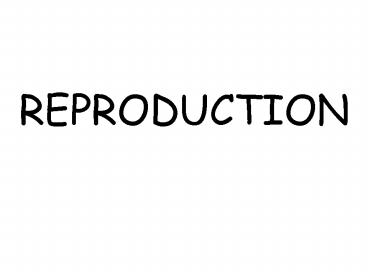REPRODUCTION PowerPoint PPT Presentation
1 / 28
Title: REPRODUCTION
1
REPRODUCTION
2
Reproduction
Reproduction means producing new living things.
Animals and plants reproduce to make new
individuals of the same species.
What would happen if living things did not
reproduce ?
There are two main ways of reproducing Asexual
reproduction Sexual reproduction
3
Sexual Reproduction
- Reproduction in most
- animals including humans
- is sexual.
- It involves sexual
- intercourse or mating
- of a male and female.
- Some plants reproduce
- sexually.
Barnacles mating
- It involves the formations of gametes (sex
cells) during meiosis and is followed by
fertilisation to produce a zygote.
4
As both parents contribute part of themselves
this results in offspring of a mixture of
genetic information of their parents.
Therefore it is a source of genetic variation
- Variation can occur
- in meiosis
- or
- b) at fertilisation
A fertilised human egg
5
Fertilisation can take place outside the body ,
for example, in water external fertilisation
Or as in mammals like birds and reptiles the
sperm and egg join inside the body of the female
internal fertilisation
6
References
- Roberts p. 322, 380 -381
- Worksheet Asexual Reproduction
- Dobson p. 137 -138
7
(No Transcript)
8
Asexual Reproduction
- Most plants and primitive plants reproduce
asexually. - There is no mating of male and female.
- Requires only one parent.
- It occurs when part of parent becomes detached
and grows and develops separately. - Plants form bulbs, tubers, or runners.
- It involves mitosis
- All offspring are identical to parent
- They are called clones.
9
Cloning
In cloning offspring have identical genes because
they were produced by mitosis
Methods of producing clones
- Binary fission and budding
- Vegetative Propagation
- Cuttings
- Tissue culture
10
Vegetative Propagation
A new plant grows out from part of the parent
plant
Strawberry runner
Potato eyes
Spider plant
11
a) Runners eg strawberries
12
b) Tubers eg potatoes
13
c) Corm eg crocus
14
d) Rhizome
15
Examples of Binary Fission (splitting) and
Budding
Hydra budding
Amoeba splitting
Yeast budding
16
Spores eg ferns
17
Advantages and Disadvantages of asexual
reproduction
18
Artificial Propagation
Cuttings GraftingTissue Culture
19
Taking a cutting
20
Taking a cutting
- 1. Choose a healthy plant
- 2. Cut a piece from a stem.
- 3. Place in water or
- Dip in water and then rooting hormone powder
- 4. Place in soil.
Disadvantages takes time Small number of new
plants produced.
Advantage Identical new plants produced
21
Grafting eg rose trees
Useful if plants are difficult to grow from seed
22
Cloning - Tissue Culture
Explants growing in nutrient s agar
23
The essentials of commercial cloning
- Advantages of Tissue culture
- Very fast
- Very little space needed
- Can grow all year no problem with weather or
seasons - New plants are disease free
- All characteristics are known
- New plants can be developed.
- Disadvantages
- Reduced gene pool
- Leading to vulnerability to new diseases
- Ethical problem of playing God.
24
Tissue culture in action Cloning a carrot plant
25
Tissue culture in action
Cloning a frog
26
Tissue Culture
- 1. Choose a healthy plant
- 2. Remove using a scalpel small pieces (explants)
- from a stem
- 3. Sterilise explants using weak bleach solution
- 4. Place explants on culture medium (agar)
- 5. Place on sealed jars at correct temperature
- and light
- 6. Observe one month later
Advantages Identical plants produced Numerous
plants produced
NB- Aseptic conditions
27
Types of Reproduction Summary
- SEXUAL
- Needs 2 parents
- Needs a mate
- time consuming
- Produces variety in
- offspring
- Fewer offspring
- produced
- ASEXUAL
- Needs 1 parent
- Produces no variety
- within species
- Occurs rapidly
- Numerous
- offspring produced
28
Work to do
- Use Roberts p. 320, 388-1 and worksheet
- 1. Describe how a potato, iris ,strawberry plant
and spider plants produce new plants - 2. Cloning (Revision book p. 112/113 and use
Dobson p. Q.7 138 to help) - Give step by step instructions for taking a
cutting and then making a tissue culture.

